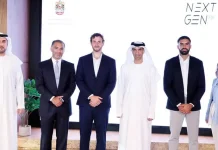Siemens Energy is launching new virtual reality (VR)-based solutions in the Middle East, specifically tailored to power transmission companies, allowing them to remotely test, validate and train employees. The new innovative solutions will help clients ensure business continuity, at a time when the global COVID-19 pandemic resulted in travel restrictions and social distancing precautions.
The utilization of augmented reality (AR) and the VR technology in the power transmission sector will have a great impact on both time and cost, based on the different applications of this technology. For example, Factory and site Acceptance Tests as well as training can be done remotely and in real-time.
The new solution is based on the usage of a smart helmet by mounting a portable 360º camera on the helmet of the person performing the test. A hands-free tablet or a wearable computer is also connected to the helmet. Footage from the camera will be streamed live to the customers who will be virtually transported, across different locations. VR-supported goggles allow the customers to navigate through the equipment, during the testing, in a real-life immersive experience.
“The energy companies are focusing on operational efficiency, improved quality, increased production, high uptime, and ease of monitoring and controlling the critical infrastructure. Grid operators are now embracing new digital solutions that will help them achieve those goals,” said Mahmoud Hanafy, Senior Vice President, Siemens Energy Transmission Solutions in the Middle East.
Siemens Energy’s Transmission Solutions team in the Middle East are deploying this approach at a number of sites across the region. The online, live stream allows for numerous functions, including real-time virtual reality mark-up for remote guidance and site surveying for greenfield projects that are inaccessible.
“In the past, conducting factory tests would typically require professionals and customers to travel abroad, incurring additional costs in addition to spending more time. Now, the new solutions can drive long-term new business models, helping reduce the carbon footprint, it’s also about adapting to the new way of working digitally,” he added.

























